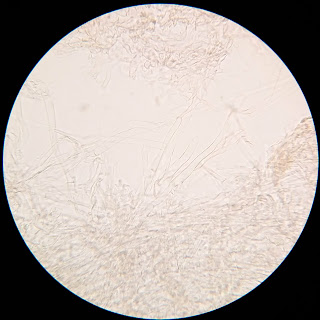Lepiota 1
Location: Among grass by the entrance to the Walled Garden. Tilgate Park.
Odour: No particular odour detected.
Cap: Centre pale brown, cracking into concentrical, patchy scales, revealing white underneath.
Stem: White, silky.
Spore print: Creamy-white.
Cap without greenish colours
Cap and/or stem with brown to orange colours
Pileipellis... This is a thin 'scalp' section off the top of the cap. Can't really figure out what I'm looking at here. Is it a hymeniderm? It doesn't really look like the illustration in Funga Nordica (26C).
 |
| Can't remember if this was 400x or 1000x magnification. |
Spores: Dextrinoid. 7-8 microns long and approx 3 microns wide. Kind of bullet shaped with a spur on one corner of the flat end.
 |
| 1000x magnification. Mounted in water. |
 |
| 1000x magnification. In Melzers (showing dextrinoid reaction). |
Spores match L. cristata (543E)
Is this a bunch of cheilocystidia? If so, they're kind of maraca-shaped ('clavate').
 |
| 1000x magnification. |
Lepiota 2
 |
| Lower stem under the stereomicroscope, showing patches of cap colour. |
Location: In woodland, under Alder. Tilgate Park.
Odour: No particular odour detected.
Cap: Centre dark brown. Covered in brown pointed scales, with brown (you could possibly describe it as bronze, at a push?) colour extending all the way to the margin.
Stem: Beige-brown at the apex. Then brown further down, with patches of cap colour.
Spore print: Creamy-white.
Cap without greenish colours
Cap and/or stem with brown to orange brown colours
Pileipellis... This is a thin 'scalp' section off the top of the cap. Again, don't really get what I'm looking at here. I'm gonna go with...
Pileipellis of elongate cells
 |
| I think this was at 1000x magnification. |
Spores: Dextrinoid. 9 - 9.5 microns long and 3-4 microns wide. Spurred, with a more pronounced bulge off to one side, compared to collection above. Looks more like illustration for L. grangei in Funga Nordica (541E), although not as pointed at the tip.
Spores spurred.
This takes me to a description of L. boudieri.
Some elements appear to match:
- Pileipellis elements are septate, with clamps (yes, I think so, see below)
- Spore shape and size is a reasonable match
- BUT cap description seems a bit off; and stem in this collection is not 'widening towards base'
I think I got a look at some cystidia here (hard to see, as they didn't take up the stain) - cylindrical to clavate?
Not too confident with this one. I think I've probably gone wrong because the collection doesn't look like photos of L. boudieri.
Lepiota 3
Pretty sure this one's L. cristata again, as Nick observed smell of 'coal gas'.Location: Pathside. Tilgate Park.
Odour: 'Coal gas'
Spores 6-7 microns long and approx 3 microns wide. Spurred.
Pileipellis
 |
| Cystidia? |
 |
| Basidium? |
Lepiota 4
Location: Worth Park
Odour: Yes. Just smells mushroomy to me.
Cap: Centre brown, turning beige towards the edges (not white). Some concentric cracking around the centre, but not as patchy as in (1) and (3) above.
Stem: Cream at the apex to brown lower down, with girdles of (beige) cap colour around the lower half of the stem.
Spore print: Creamy-white.
Cap without greenish colours
Cap and/or stem with brown to orange colours
Pileipellis
A hymeniderm?
Spores Dextrinoid. 7 microns long and 3-4 microns wide. Ellipsoid.
Spores ellipsoid
I think this is an image of cheilocystidia, stained with PlaqSearch.
Cheilocystidia present
This takes me to L. ochraceofulva.
- Spore shape and size matches.
- Cheilcystidia narrowly clavate.
- A few scattered girdles of cap colour at the base.
- Gills remote from stem.
 |
However, other features seem like not such a good match:
- Not seeing shades of orange / yellow
- Looks to me like it turns brown with handling (not orange)
- There is a smell to it, but I'm not getting 'orange chocolate' or 'unpleasant'
If you've got this far - thank you! - any advice gratefully received.

















No comments:
Post a Comment